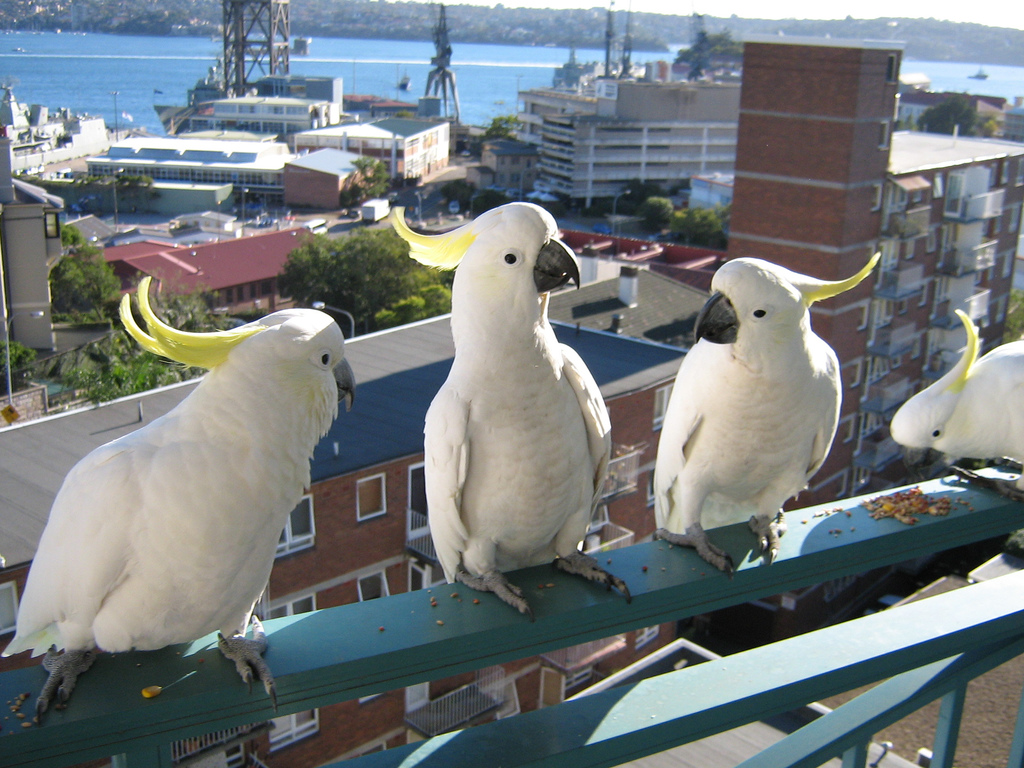
Cockatoos in Sydney Harbor. Photo © Sarah Baker, licensed Creative Commons Attribution.
Utterly unique and enchanting, many of Australia’s animals could be from a fairy tale. Apart from the scientific marvels such as the monotremes, or egg-laying mammals, which include the platypus and the prickly echidna, there are the marsupials, mammals that carry their underdeveloped young around in a cozy pouch until they are ready for the world, along with vast colorful birdlife and a few creepy-crawlies thrown in for good measure. Yes, there are nasty spiders and dangerous snakes in this country, but generally they stay out of your way and are not really interested, unlike the possums.You know you have settled in Australia when at sunset flocks of cockatoos perch near you, making an incredible noise; red, green, and pink parrots regularly come into your garden looking for seeds and nuts; possums clamber around the electric wires outside your house at night; and maybe, if you are very lucky on a country drive on the weekend, you spot an elusive koala nestling in the fork of a tree, or indeed see a kangaroo powerfully propelling itself through the bush. Yes, there are nasty spiders and dangerous snakes in this country, but generally they stay out of your way and are not really interested, unlike the possums. They actively come down from the trees to have a good look at you, and while it is illegal to hug a koala in most states, you can—if you can’t find one in the wild—get a close look at these eucalyptus-munching cuties in any nearby wildlife center and appreciate that you are truly living in Australia.The rabbits by the side of the road, the camels ruminating in the desert, those poisonous toads that scare everybody—none are native to Australia, but they are very common and are usually a pest. Those cute button-nosed bunnies were imported by a farmer from Britain because he wanted to have something to shoot at in the back garden.
Not many years later those 20 or so rabbits had produced uncountable new generations that literally changed Australia’s landscape from shrubby undergrowth to desert. The introduction of the myxomatosis virus decreased the numbers, but only for a while, until new generations had become immune to it. The camels were imported because they suited the large desert regions in Australia, and now they have gone native and are so prolific that they are exported to the Middle East. The cane toads were introduced to combat an epidemic of beetles that were munching on the sugarcane harvests, and while they managed to get rid of the beetles, they are now a pest themselves without natural predators.
Even the iconic dingo didn’t initially belong here, introduced thousands of years ago by the aborigines, who had dogs. Since then, the dingoes have thrived; they thieve from farmers to such a degree that a 5,400-kilometer-long dingo fence, reportedly the world’s longest fence and one of the world’s longest structures, was built between South Australia up to Queensland, trying to keep the dingoes and farm animals apart. Probably the best-known nonnative species is sheep, brought from South Africa by some of the first British settlers to establish the wool industry. And where would we be today without the famous Australian sheepskin boots and Australian lamb?